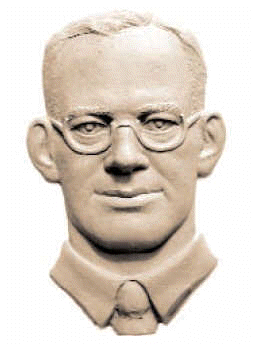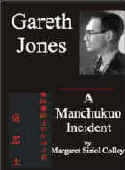Gareth Jones
[bas relief by Oleh Lesiuk]
HOME |
Stop Press |
Complete Soviet Articles & Background Information |
Précis of Gareth's
|
All Published Articles |
BOOKS
|
|
|
|
More Than Grain of Truth(2005) |
|
|
TOPICAL
'Are you Listening NYT?' U.N. Speech - Nov 2009 |
Gareth Recognised at Cambridge - Nov 2009 |
Reporter and the Genocide - Rome, March 2009 |
Order of Freedom Award -Nov 2008 |
Premiere of 'The Living' Documentary Kyiv - Nov 2008 |
Gareth Jones 'Famine' Diaries - Chicago 2008 |
Aberystwyth Memorial Plaque 2006 |
GENERAL
Scholarship Fund |
Site Map |
Links |
Legal Notices |
Sponsored Links |
Contact |
The New York Times. 22 June 1931
SOVIET FIXES OPINION BY WIDEST CONTROL
Added to Press and Radio Are 10,000,000 Reds, Old and Young, to Foster Stalinism.
-----------------
SELF-CRITICISM IS A VENT
-----------------
Permits Great Volume of Complaints, but Holds Them Within Bounds of Bolshevism.
-----------------
ART IS BECOMING FREER
-----------------
Stalin Himself Is Said to Have Rebelled at Trammeled Work Submitted to Him.
This is the sixth of a Series of articles on Russia today by The York Times Moscow correspondent, who is at present in Paris.
By WALTER DURANTY.
Special Cable to The New York Times.
PARIS. June 21—It may be said without fear of contradiction that the Stalinist machine is better organized for the formation and control of public opinion in a great country than anything history has hitherto known. Perhaps Mormonism during the flourishing period of Brigham Young might be offered as a rival, but that was on a relatively tiny scale and failed to endure.
Stalinism, on the other hand, has three tremendous instruments – first, the Communist party plus, the Communist Youth and the Young Pioneers to a total of fully 10,000,000 of the most energetic section of the population highly centralized, sternly disciplined and trained to fluent speech and the subtle art of propaganda.
Second, there is the press from the great central organs like Pravda and Izvestia with circulations of millions, to the village and factory newspapers, multigraphed or handwritten by the tens and twenties of thousands. All follow the same line, obey the same control and preach the same gospel.
Radio Has Mysterious Appeal.
Finally, the Stalinists control the radio, the appeal of which to the more ignorant people who cannot read gas something mysterious and superhuman. During the past two or three years of the Soviet Union has been covered by a network of powerful transmitting stations, each serving a wide region. Though nation-wide hook-ups on the American scale are still a dream of the future, every factory and collective farm now has a loudspeaker, which in the final analysis is nothing but a fountain or Stalinism.
The labor federation and the Red Army also are harnessed to the Stalinist cause in an effective manner, but attempts to make literature, art and the drama serve the same purpose have been less successful, and there are signs of a reaction against purely proletarian or propaganda art.
A story goes that Joseph Stalin was instrumental in obtaining an exit visa for Boris Pilnyak, who had acquired some dislike through the “literary” and “non-proletarian” quality of his writings. It is also said that Stalin sharply rebuked the extreme Left Wing of the proletarian writers, whose code was that no literary skill or talent was necessary that a coal miner could best write a novel about mines, a worker about factory life, and a conscript soldier about war, and that all novels or stories mast have a strong propaganda purpose.
Stalin is reported to have told them he personally preferred Shakespeare and that if they had read more of Shakespeare and Pushkin they would produce less rubbish like this,” whereupon he threw back across a table a crude slipshod work by one of the younger proletarian writers, which had been submitted for his approval.
It cannot be said, however that the Kremlin abuses the terrific power of the press, the radio and Communist party effort. Stalin may not be one of the world great men in the sense that Lenin was, but he certainly “knows his politics” and has been careful to correct the dangers of unchallenged authoritative and unified control of public opinion by what is known as “self-criticism,” which is not the least interesting feature or the Stalinist system.
Self-criticism is the salt in the Soviet home propaganda pie. It enables any writer or speaker, high or low, to take a violent and enjoyable crack at almost any one or anything, provided he sticks to concrete facts or remains ‘objective,’ as the Russians call it, and refrains from the unwisdom —or positive danger — or ideological criticism or covert attacks on the “party line” which will brand him with heresy and disgrace.
The Russians by nature have a streak of anarchic iconoclasm, be they never so loyal Communists, and “self-criticism” gives them welcome relief from the stark rigidity of Stalinism,. a relief no less delightful because it is apt to be dangerous. There have been cases when over-zealous critics have been compelled to make ignominious retractions or have lost their jobs or even been expelled from the party.
Self-Criticism is Widely Used
But it is a splendid safety valve, none the less, and so widely used by the Moscow press in particular, which is closest of course to the Kremlin, that a foreign observer often wonders whether everything is “going to the bowwows,” so long and grievous is the tale of mismanagement, waste and bureaucratic error. Its chief beauty is that few save the very highest dignitaries are spared from blame. Some cub reporter on The Communist Youth Pravada or an illiterate worker can sling a pebble at the Railroad Commissariat and get away with it if he only has got facts to back his charge.
To a foreign correspondent self-criticism is a potent though double edged weapon. As a skate for thin ice it has unrivalled usefulness—and peril. To employ it brings the rhythmic charm of perfect balance; to misuse it means disaster. And the uncertain chance of one or the other makes the difficult and often dreary life of the American reporter in Russia so infinitely worth living.
© The New York Times. 1931. N.B. The executive editor of The New York Times, Bill Keller, told The Washington Post on October 23 2003, that the newspaper would have no objection if the Pulitzer Prize Board wanted to revoke Mr. Duranty's award. Mr. Keller called Mr. Duranty's work "pretty dreadful. ... It was a parroting of propaganda." It will be taken as read that no royalties are due on this un-authorised reproduction of this article As such they are also perceived, as having no truthful value whatsoever, are only reproduced for academic and educational purposes, not intended to defraud The New York Times of any morally legitimate royalty revenue and are published without financial gain. In any event, the copyright for the above may well only reside, 70 years after its publication with the heirs of Walter Duranty, and with whom we have no personal animosity whatsoever. Nevertheless, any contention of copyright violation may by taken up under the jurisdiction of English Law. My service address for any legal correspondence is: Nigel Linsan Colley, 1, Crown Street, Newark, Nottinghamshire, England, NG24 4UY. Any prosecution will, you can be assured, be defended in the public domain.
|
|
|
|



